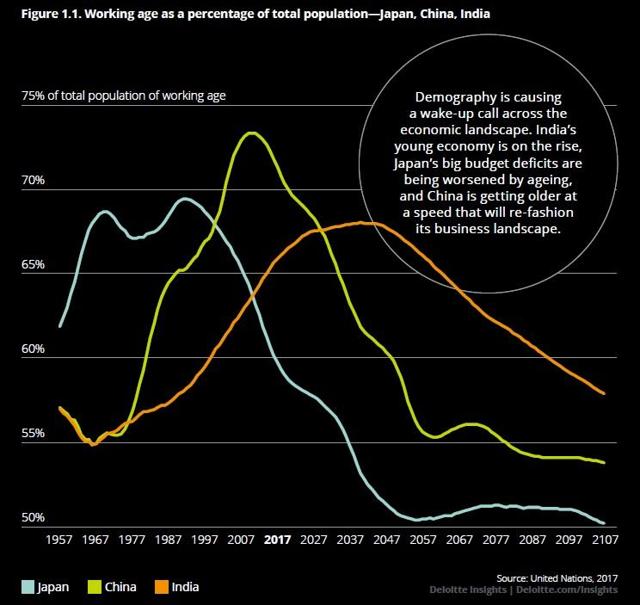Demography Rebalances Asia. Golez: Declining work force of China, Japan. India Rising. https://t.co/qn8uTE9cex $VPL $AIA $IPAC $ADRA $RFAP
1. DECLINING WORK FORCE OF CHINA, JAPAN. INDIA RISING."This figure shows the working-age share of the total population for Japan, China, and India. In Japan, this percentage rose and peaked during its period of rapid economic growth in the 1960s and 1970s. For China, the percentage rose in recent decades, and is now forecast to drop sharply. For India, the percentage is still rising.
2. The report notes: "India will account for more than half of the increase in Asia's workforce in the coming decade. The consequences for businesses are vast: An Indian summer is coming, and it will last half a century. And while India's rise might have the largest impact on the world, it isn't the only economy set to surge, with Indonesia and the Philippines on track to enjoy similar trends. Both of these nations have a relatively young population, mainly because they still have birth rates in excess of the global average. This makes demographics a tailwind rather than a headwind for their growth across at least the next 20 years."
3. AGING POPULATION OF JAPAN, CHINA. YOUNG POPULATION OF INDIA. "Or to put it another way, the median age in Japan is 47 years; in China, 37 years; in India, 27 years. These are dramatic differences. In the table, you can see where other Asian countries stand in terms of being older or younger."
Demography Rebalances Asia
Demographic shifts are about more than economics. Think about an array of social institutions: schools, parks, libraries, building and housing codes, public transportation, healthcare, the size of the volunteer sector. All of these, and many others, take on differing importance and shape when an economy has a relatively high number of children, or working-age people, or retirees. Deloitte has published the third edition of Voice of Asia (September 2017), with a focus on "Demographics fuelling Asia's shifting balance of power." Here are some thoughts from the report.
This figure shows the working-age share of the total population for Japan, China, and India. In Japan, this percentage rose and peaked during its period of rapid economic growth in the 1960s and 1970s. For China, the percentage rose in recent decades, and is now forecast to drop sharply. For India, the percentage is still rising.
The report notes: "India will account for more than half of the increase in Asia's workforce in the coming decade. The consequences for businesses are vast: An Indian summer is coming, and it will last half a century. And while India's rise might have the largest impact on the world, it isn't the only economy set to surge, with Indonesia and the Philippines on track to enjoy similar trends. Both of these nations have a relatively young population, mainly because they still have birth rates in excess of the global average. This makes demographics a tailwind rather than a headwind for their growth across at least the next 20 years."
Or to put it another way, the median age in Japan is 47 years; in China, 37 years; in India, 27 years. These are dramatic differences. In the table, you can see where other Asian countries stand in terms of being older or younger.


No comments:
Post a Comment